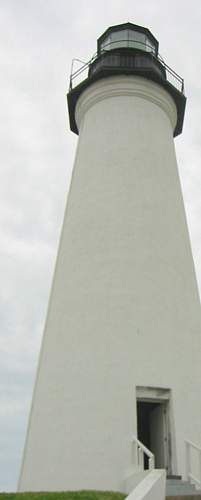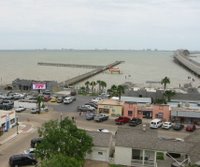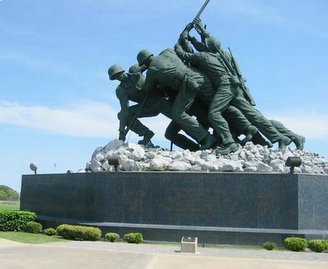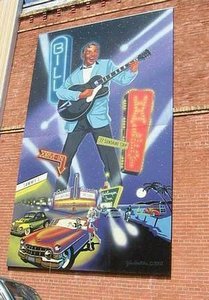
On the day we visited the Port Isabel Lighthouse, there were several bus loads of school kids taking a field trip to the lighthouse and the surrounding museums. We managed to slip in between groups.
From the outside, the lighthouse did not appear that tall to me, but that impression quickly changed after climbing the steps and looking out from the top. It's plenty tall, and the gusty day guaranteed an even firmer grip on the railing that circled the top platform.
Next to the lighthouse is the lighthouse Keeper's Cottage, which now houses the Chamber of Commerce. The facility has an interesting exhibit on the history of the lighthouse, and this is where you buy lighthouse tickets. We purchased a combination ticket where you can visit the lighthouse and two other museums in town, all within walking distance of one another. The combination ticket is 7 dollars a person; at 3 dollars a site, you save 2 dollars.
Lighthouse History
Before the lighthouse, there was Fort Polk. Tensions were heating up with Mexico after the U.S. annexed the Republic of Texas, which Mexico viewed as a slap in the face. Despite the Republic of Texas winning independence from Mexico in 1836, Mexico never really conceded their loss. To prepare for potential trouble, President Polk sent General Zachary Taylor into south Texas. General Taylor arrived at Port Isabel, which was then known as El Fronton de Santa Isabel, in the Spring of 1846.
The fort was built where the lighthouse now stands and was used as a supply depot and hospital during the war that eventually ensued. Additionally, the town was renamed Point Isabel. The war ended in 1848, and, two years later, the army handed the fort over to the U.S. Treasury Department for customs service use.
In 1850, with urging from Texas delegates, Congress appropriated 15,000 dollars for two navigational aids to serve the harbor at Brazos Santiago. One of these navigational aids was to be a lighthouse, the other a beacon. At first, South Padre Island was considered for the lighthouse location, but local shipping experts argued that the Fort Polk location offered a more stable foundation and was protected more from the onslaught of hurricanes. Also, the government already owned the land at Fort Polk. In the end, this location won out, and South Padre Island got the beacon.
Unlike the cast iron lighthouses serving Galveston and Matagorda at this time, the Port Isabel Lighthouse was constructed with brick. The lighthouse was completed in 1853 and first lit the night sky on March 20, 1853. The light remained lit until the beginning of the Civil War in 1861. Confederates removed the light so it would be useless if Union hands got a hold of it. Two years later, they really tried making it useless by blowing up the tower with gunpowder. The lighthouse survived the explosion and was later repaired. It shone again, after the war, on February 22, 1866.
Things went well until 1882 when the Lighthouse Board realized they had no title papers for the lighthouse. Four years later, the board received a letter from James B. Wells Jr. who claimed ownership; that following year, he sued the lighthouse keeper for trespassing on his property. The board wanted to purchase the property, but Wells' offer of 6,000 dollars was considered exorbitant, so, in 1888, the lighthouse went out of service because of the land dispute.
In 1894, after public pressure to restore the lighthouse, the Lighthouse Board settled out of court with Wells, purchasing the lighthouse and land for 5,000 dollars. On July 15, 1895, the light once again shone from Point Isabel. This lasted for 10 years. With the completion of railways into south Texas, the lighthouse was deemed unnecessary for commerce. It went dark for good on August 1, 1905.
In January of 1928, the lighthouse was sold. It went to the highest bidder, who happened to be a J.S. Ford. He purchased it for 2,760 dollars and turned around and sold it two months later to the Port Isabel Town Company for 5,000 dollars. The town company wanted the landmark to help promote the town, which they renamed Port Isabel, for tourism and industry. The town company later went bankrupt, succumbing to the depression.
In 1947, the Texas Legislature said it was ok for the Texas State Parks Board to acquire the lighthouse, and they put up 25,000 dollars for its repair and maintenance. The state didn't own the property, but this was not an issue. The owners Mr. and Mrs. Lon C. Hill, Jr. donated the lighthouse and surrounding land as a gift in 1950. (I would bet that Lon C. Hill, Jr. is the son of the founder of Harlingen; see a previous post on Harlingen.)
On April 26, 1952, the lighthouse was dedicated as a state park. The Port Isabel Lighthouse is the only lighthouse on the Texas Gulf Coast open to the public.
Books:
- Baker, T. Lindsay, Lighthouses of Texas, College Station: Texas A&M University Press, 2001
- Parent, Lawrence, Official Guide to Texas State Parks, Austin: University of Texas Press, 2000
Return Home


